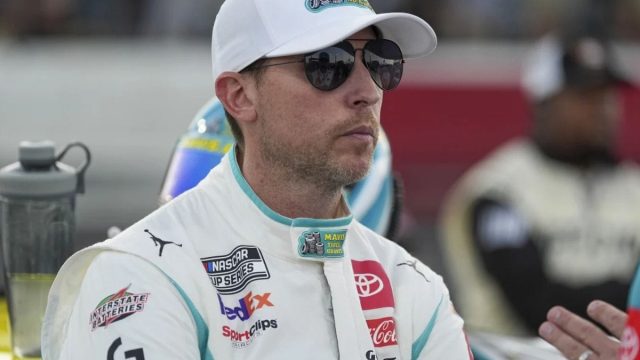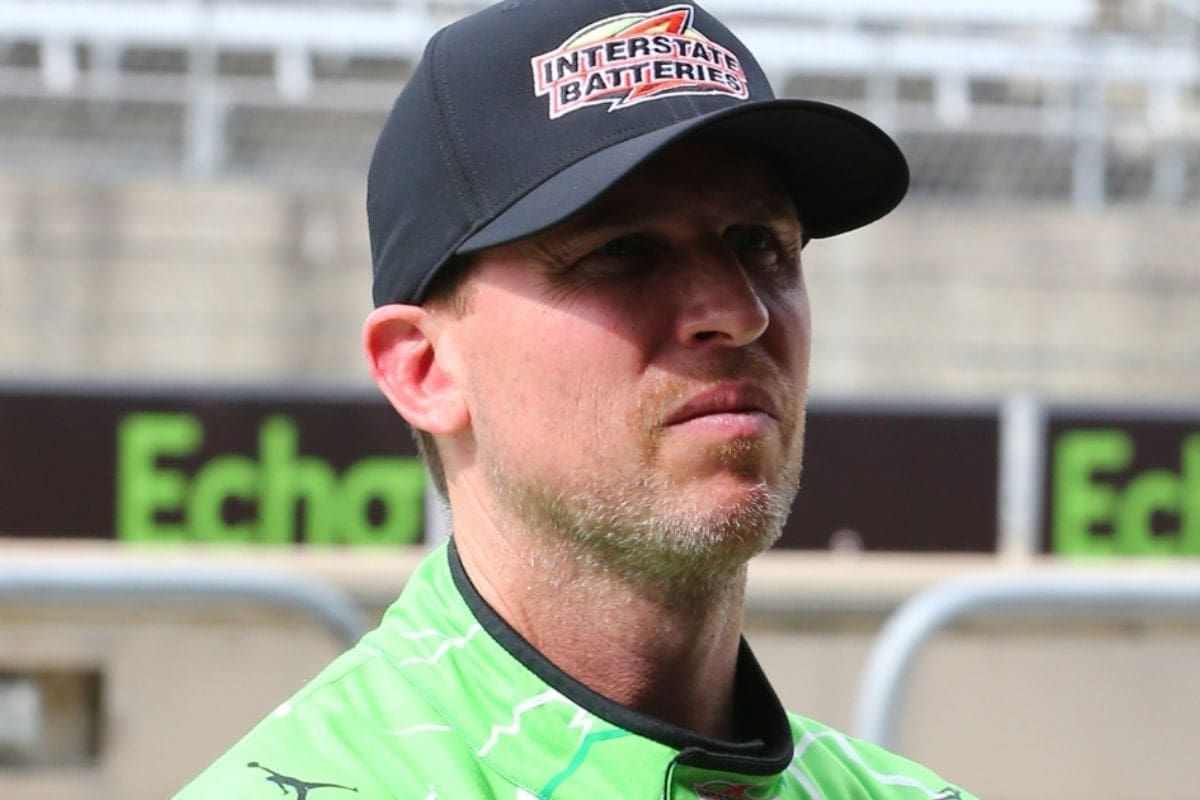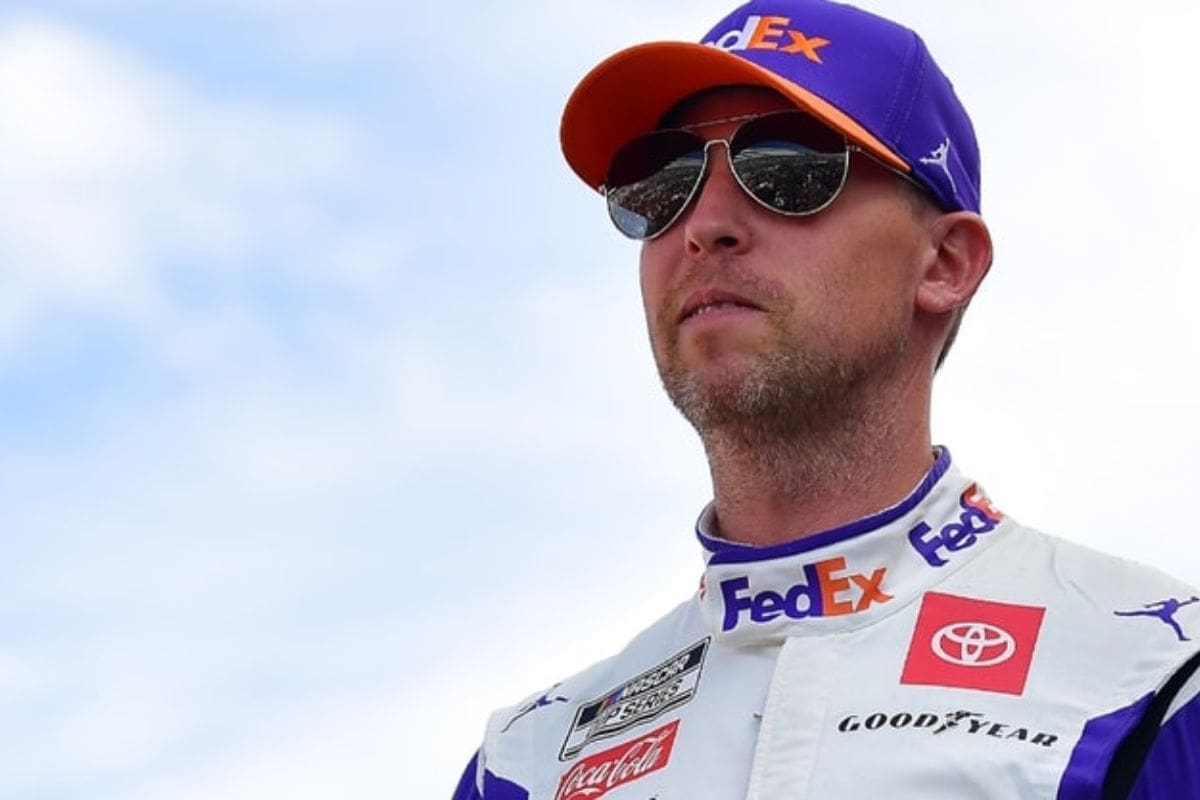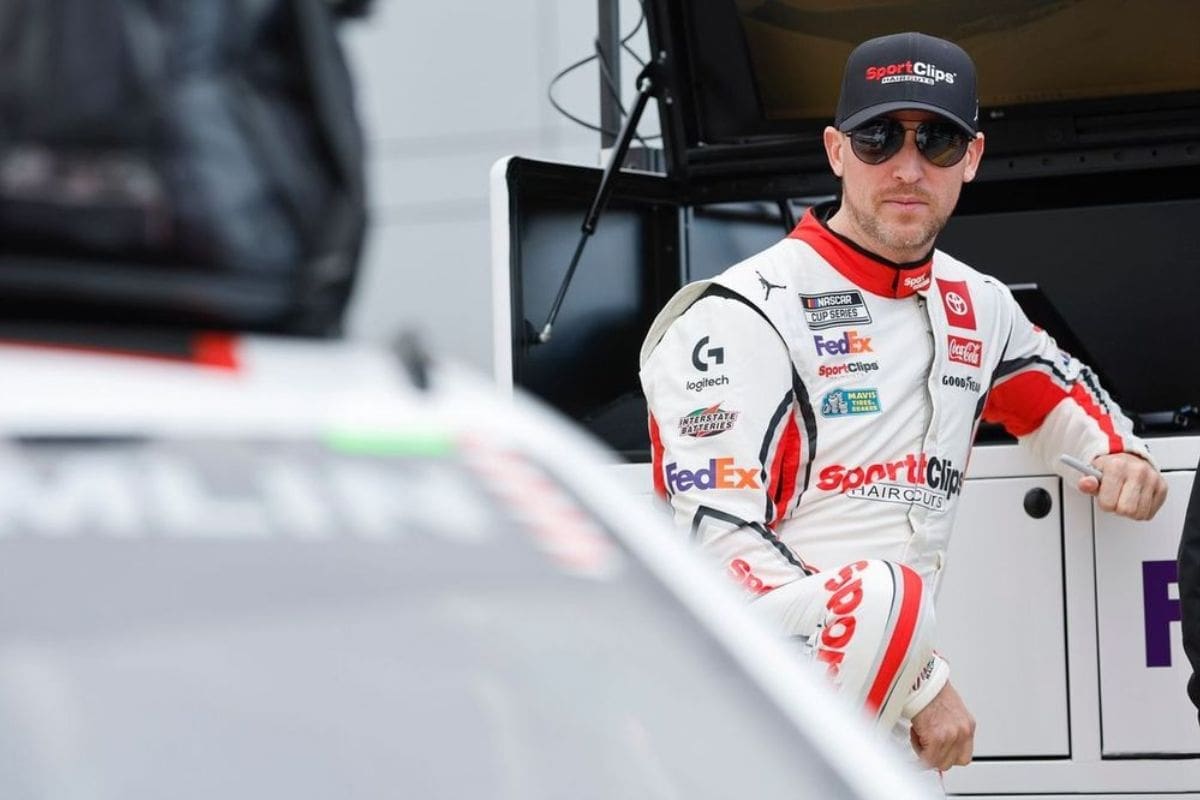Denny Hamlin Reflects on NASCAR’s Caution Call: In a recent episode of his podcast, Denny Hamlin‘s reflections on NASCAR’s caution call during the Hemric incident have sparked a detailed discussion within the racing community, delving into the delicate balance between safety measures and race integrity. Hamlin’s critical analysis of the caution’s timing not only highlights the strategic complexities drivers and teams must navigate but also shines a light on NASCAR’s officiating protocols. This scrutiny brings to the forefront questions regarding the consistency, transparency, and fairness of such decisions.
Key Highlights
- Denny Hamlin questions the timing of the caution call for Hemric’s tire blowout on his podcast.
- Hamlin suggests the caution disrupted the race flow and affected strategic race management.
- Hamlin’s reflections contribute to the broader debate on NASCAR’s officiating consistency.
- The Hemric caution’s impact on race dynamics and fairness is a focal point in Hamlin’s critique.
- Hamlin’s insights emphasize the balance needed between safety and competitive integrity in NASCAR.
Stage 2 Caution at Iowa Corn 350
During Stage 2 of the Iowa Corn 350, NASCAR’s decision to deploy a caution following Daniel Hemric’s tire blowout and subsequent wall contact has ignited a debate over the necessity and timing of such interventions.
The incident, wherein Hemric’s vehicle suffered a tire failure and grazed the wall without involving other competitors or sustaining significant damage, has brought the judgment of race officials into sharp focus.
From a regulatory and safety standpoint, NASCAR’s caution flags serve as essential tools to safeguard the well-being of drivers and the integrity of the race. However, the timing and perceived necessity of this particular caution have led to polarized opinions among drivers and analysts.
Supporters of the caution argue that any incident involving potential debris on the track or compromised vehicle control justifies a caution to preemptively mitigate risk. The unpredictable nature of tire failures, coupled with the chance of undetected damage, supports a cautious approach to safety. Moreover, the presence of debris, even if not immediately visible, poses a latent threat to the trailing vehicles.
Conversely, critics posit that the caution was an overreaction, suggesting that it disrupted the natural flow of the race unnecessarily. They argue that Hemric managed to maintain control post-impact, and the absence of significant debris did not necessitate a caution. This perspective emphasizes the importance of maintaining competitive racing conditions without undue interruption.
Denny Hamlin’s Perspective
Amid the ongoing debate over NASCAR’s caution call at the Iowa Corn 350, Denny Hamlin offered a detailed view on his podcast, ‘Actions Detrimental’ highlighting the rationale behind the caution and the possible influence of the race’s extended green-flag period. Hamlin’s perspective is particularly remarkable given his extensive experience in the sport and his sophisticated understanding of race dynamics and officiating decisions.
“He did hit the wall, but I think there’s, I don’t know how long we had gone green during that moment, but I’m always of the opinion that if we go really long stretches of time without a caution, be aware you’re going to get one for something superficial at times.” – (hamlin)
Hamlin expressed a degree of ambivalence regarding the caution triggered by Daniel Hemric’s encounter with the wall. He acknowledged the incident’s legitimacy but questioned the timing of NASCAR’s response. Specifically, Hamlin observed that the caution seemed to be influenced by the preceding lengthy green-flag run.
This suggests that NASCAR officials may have been inclined to introduce a caution not solely based on the severity of Hemric’s incident but also to break the monotony of an extended green-flag period and potentially reassess the race’s competitive balance.
NASCAR’s Caution Criteria
Examining NASCAR’s caution criteria reveals a complex framework that balances safety considerations, competitive integrity, and the entertainment value of the race. The decision to call a caution is not taken lightly and involves multifaceted judgment calls by race officials. These decisions are influenced by factors such as the location and severity of the incident, potential hazards to drivers and spectators, and the impact on the race’s competitive dynamics.
The recent race highlighted this complexity with several incidents of blown tires occurring on laps 132, 165, and 174, none of which prompted a caution flag. However, the incident involving Daniel Hemric did result in a caution, sparking debate over the consistency and transparency of NASCAR’s criteria.
“Did they hit the wall, though? You know what I mean? Like the 31 hit the wall. I don’t know that he brushed it, but he hit it pretty good. I was right somewhat near him when this happened. Yeah, it’s just, it certainly did not help some of the leaders, but the 12 had pitted and then he came back and won the race. So I think that it’s still the fastest cars found themselves up front at the end.” – (hamlin)
NASCAR defends its decisions by emphasizing the need to address immediate safety concerns. In Hemric’s case, the incident was deemed significant enough to warrant a caution to safeguard the safety of all participants and maintain a fair racing environment. This approach highlights the governing body’s commitment to prioritizing driver safety while aiming to keep the competition intact and engaging for fans.
Christopher Bell’s Reaction
Expressing significant dismay, Christopher Bell and his crew chief, Adam Stevens, critiqued NASCAR’s caution call, highlighting the inconsistency in race officiating which they believe unfairly impacted Bell’s position on the track. Bell, who was relegated to a less advantageous position following the controversial caution, did not mince words, describing the call as ‘ridiculous’.
“That was the most ridiculous bulls*** caution I’ve ever seen in my life. You had 17 guys blow tires and you have one guy blow another tire and you throw the f****** caution. That’s chickens**.” – (Adam Stevens)
His frustration stemmed from a perceived disparity in how NASCAR handled similar incidents involving other drivers who experienced tire issues but did not trigger cautions. Bell’s argument emphasizes a critical issue in NASCAR’s officiating: consistency. The adherence to a uniform standard is crucial in maintaining the integrity of competitive sports.
Bell and Stevens pointed out that other drivers, who suffered comparable tire malfunctions, were not subjected to the same cautionary measures, thereby allowing them to maintain their track positions. This perceived inconsistency, they argue, not only skewed the competitive landscape but also eroded trust in NASCAR’s decision-making process.
Race Outcome
The controversy over Christopher Bell’s demotion due to the caution call ultimately did not overshadow the strategic skill demonstrated by Ryan Blaney, who clinched victory through a well-timed pit stop. Blaney’s success was a confirmation of the importance of strategy in NASCAR, where timing and coordination with the pit crew can make the difference between victory and defeat.
While the caution for Hemric’s incident invoked criticism and questions from drivers and teams, Blaney’s team adeptly navigated the race conditions to capitalize on the opportunity presented.
This race outcome highlights the intricate dynamics of NASCAR, where race strategy must continually adapt to the unfolding events on the track. The Hemric caution, which some felt unfairly disrupted the race order, served as a critical moment, reshaping the competitive landscape.
Blaney’s team demonstrated astute decision-making, opting for a pit stop that not only positioned him advantageously but also demonstrated the necessity of split-second judgment in racing.
News in Brief: Denny Hamlin Reflects on NASCAR’s Caution Call
The reflections on NASCAR’s caution call for the Hemric incident, as discussed by Denny Hamlin, highlight the complexities of balancing safety with competitive integrity in race management. This scrutiny sheds light on the inherent challenges NASCAR faces in refining officiating protocols to guarantee consistency, transparency, and fairness.
By addressing these concerns, NASCAR can potentially amplify the dynamics of race outcomes, ensuring that drivers and teams can strategically navigate the competitive landscape with greater confidence.
Our Reader’s Queries
Q. How did Denny Hamlin get into NASCAR?
A. During a conversation about his racing ambitions, Denny Hamlin’s plan caught the attention of a race-team owner who offered to sponsor him. Recognizing Hamlin’s talent and his knack for outperforming competitors with superior equipment, Joe Gibbs Racing soon took notice. At the age of 24 in 2005, Hamlin made his debut in the Cup Series.
ALSO READ: Denny Hamlin Criticizes NASCAR’s Charter Deals as Time Runs Out



